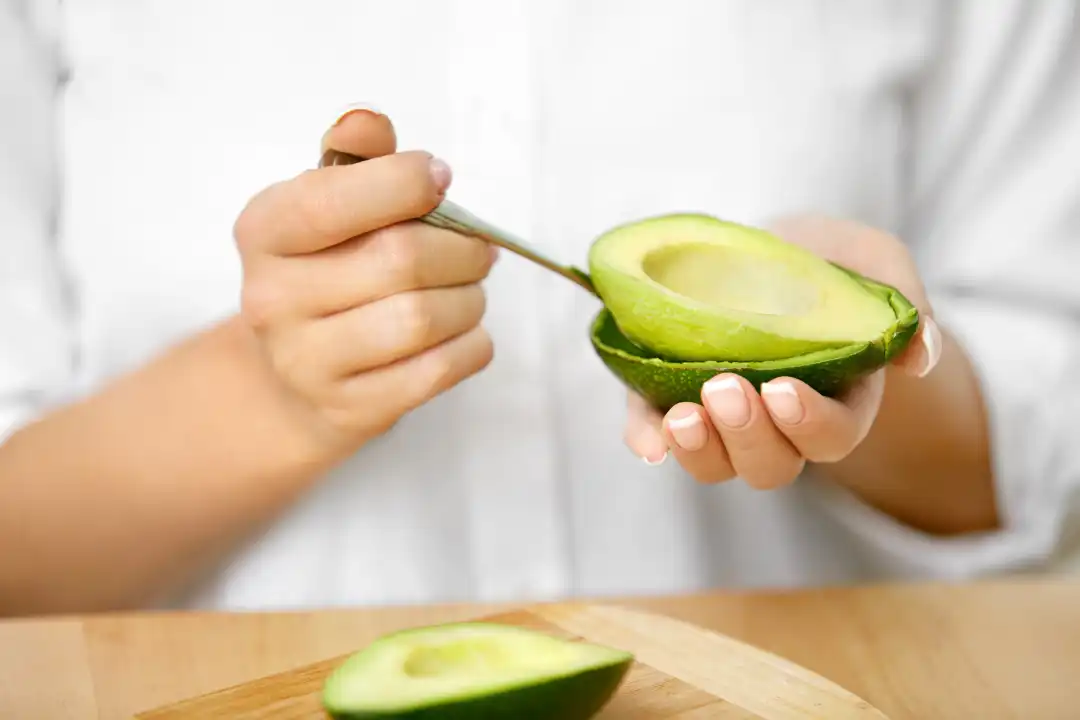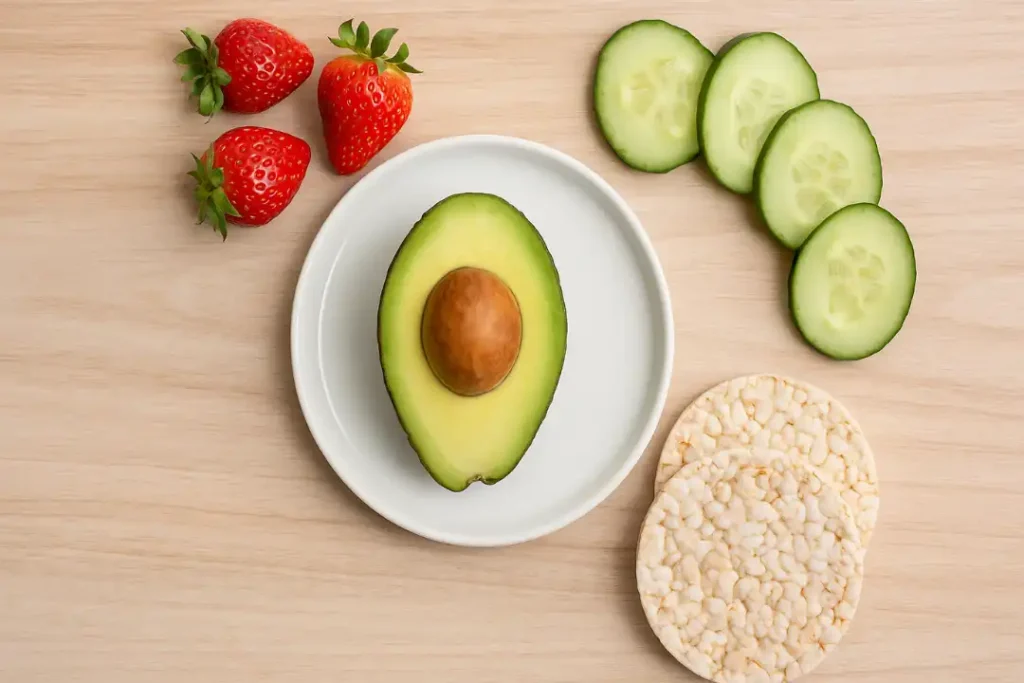If you’re following a low FODMAP diet and love avocados, you’re probably wondering, do they make the cut? The answer isn’t black and white, but recent research has cleared up the confusion. In this guide, we’ll break down exactly how much avocado you can eat without triggering IBS symptoms, plus tips to enjoy it safely. Let’s make sense of it together.
Can you eat avocado on low FODMAP diet?
Yes, you can eat avocado on a low FODMAP diet, but only in small amounts. A serving of 30g (about 2 tablespoons) is considered low FODMAP and is generally safe for most people with IBS. Larger amounts become high FODMAP due to the natural sugar alcohol perseitol.
Understanding FODMAPs and Why They Matter
Let’s start with the basics. FODMAPs are a group of carbohydrates that some people have trouble digesting — especially those with IBS (Irritable Bowel Syndrome). The name stands for Fermentable Oligosaccharides, Disaccharides, Monosaccharides, and Polyols. That’s a mouthful, but they’re basically sugars and fibers that can ferment in your gut and cause bloating, gas, cramps, or diarrhea.
Here’s a quick breakdown of the FODMAP types:
- Oligosaccharides – Found in foods like onions, garlic, and wheat
- Disaccharides – Mainly lactose, found in milk and soft cheeses
- Monosaccharides – Excess fructose, found in apples, honey, and high-fructose corn syrup
- Polyols – Found in some fruits and veggies (like avocados) and sugar-free gums (like sorbitol and xylitol)
When these carbs aren’t absorbed properly in the small intestine, they ferment in the colon and draw water into your gut. For people with IBS, this means discomfort, unpredictable bathroom trips, and frustration.
The Truth About Avocados: What the Latest Research Reveals
For years, avocados were considered high in sorbitol, a type of polyol that can trigger IBS symptoms. As a result, many people on a low FODMAP diet avoided them altogether.
But here’s the twist: recent research from Monash University revealed that avocados don’t contain sorbitol at all. Instead, they contain a different polyol called perseitol, which is unique to avocados.
So, what does this mean for your diet?
Monash University has updated its guidelines, indicating that a serving of 60 grams (about 3 tablespoons) of avocado is considered low FODMAP and generally safe for most people with IBS.
They use a traffic light system to help guide portion sizes
- Green (Low FODMAP): 60g or less
- Amber (Moderate FODMAP): 60g to 90g
- Red (High FODMAP): More than 90g
It’s important to note that while perseitol is different from sorbitol, it may still cause symptoms in some individuals. Therefore, it’s recommended to test your personal tolerance to avocado during the reintroduction phase of the low FODMAP diet.
Safe Avocado Serving Sizes
When it comes to avocados on a low FODMAP diet, portion size is everything. Avocados aren’t completely off-limits, but eat too much, and you might run into digestive trouble.
According to testing by Monash University, a small amount of avocado can be enjoyed safely by most people with IBS. That’s because the FODMAP content (specifically the polyol perseitol) increases with portion size.
Here’s what their findings show:
| Serving Size | Amount (grams) | FODMAP Level | Safe For Elimination Phase? |
|
30g (⅛ avocado) |
30g |
Low FODMAP (🟢) |
✅ Yes |
|
45g–60g |
45–60g |
Moderate FODMAP (🟡) |
⚠️ Caution |
| 75g+ | 75g or more | High FODMAP (🔴) |
❌ No |
5 Ways to Enjoy Avocado Without Triggering IBS
Good news, just because you’re on a low FODMAP diet doesn’t mean you have to give up avocado completely. The key is sticking to small, measured servings and pairing them with other gut-friendly ingredients.

Here are five delicious and IBS-safe ways to enjoy avocado in your meals:
1. On Gluten-Free Toast with a Squeeze of Lemon
Spread a thin layer (about 2 tablespoons or 30g) of ripe avocado on gluten-free toast, then add a sprinkle of salt and a dash of lemon juice for brightness. It’s quick, satisfying, and well within the low FODMAP range.
2. In Low-FODMAP Guacamole
Traditional guac is often high FODMAP because of garlic and onion, but you can still enjoy a gentler version! Mix mashed avocado with chopped green onion tops, coriander, lime juice, and a pinch of cumin. Serve with low-FODMAP corn chips or sliced cucumbers.
3. Tossed into Salads
Add a few cubes of avocado (keep it under 30g) to a salad filled with low FODMAP veggies like spinach, carrots, cucumber, and red bell pepper. It brings creaminess and healthy fats to your bowl, without overdoing the FODMAPs.
4. Blended into Smoothies
Avocado makes smoothies super creamy. Try blending 2 tablespoons of avocado with lactose-free yogurt, strawberries, and a splash of almond milk (low FODMAP when unsweetened). It’s a gentle, nourishing way to boost your fiber and fat intake.
5. In Sushi Rolls or as a Garnish
Love sushi? Many veggie or salmon rolls include a little avocado, just ask for a small portion, or make your own at home using low FODMAP rice and fillings. You can also use thin avocado slices as a topping on rice bowls or grilled proteins.
Bonus Tip: How to Store Leftover Avocado
Only using ⅛ of an avocado at a time? No problem. To store the rest:
- Keep the pit intact (it slows browning)
- Sprinkle the cut side with lemon juice or olive oil
- Wrap tightly in plastic or store in an airtight container
- Refrigerate and use within 1–2 days
This way, you can enjoy avocado in safe portions without letting the rest go to waste.
Is Avocado Oil Safe on a Low FODMAP Diet?
Yes, avocado oil is completely safe on a low FODMAP diet.
Here’s why: FODMAPs are types of carbohydrates, and avocado oil contains zero carbs. That means there’s no risk of triggering IBS symptoms through FODMAPs when you cook with or consume avocado oil.
Even better, avocado oil still delivers many of the nutritional benefits of whole avocado, like heart-healthy monounsaturated fats and antioxidants, without the portion size worries.
How to Use Avocado Oil:
- Cooking: It has a high smoke point, so it’s great for roasting, grilling, and sautéing.
- Drizzling: Add a splash over roasted veggies or grilled fish for extra flavor.
- Salad Dressings: Blend with lemon juice, mustard, and herbs for a gut-friendly homemade dressing.
So, if you love the richness of avocado but want to play it safe during the elimination phase, avocado oil is your go-to alternative, all the flavor, none of the FODMAPs.
My Journey with Avocado and the Low FODMAP Diet
When I first started the low FODMAP diet, I thought avocado was completely off-limits, and honestly, I was pretty disappointed. It had always been a go-to ingredient in my meals. But once I learned that small portions could still be safe, I decided to test it out during the reintroduction phase. I started slow, with just one tablespoon on gluten-free toast, and gave my body time to react. To my relief, I had no symptoms, so I gradually increased to 2 tablespoons (around 30 grams), which became my personal safe zone.
Since then, I’ve made avocado part of my routine again, just in moderation. I’ve also fallen in love with avocado oil. It gives me the same flavor and healthy fats without the FODMAP risk, especially when I’m cooking or making dressings. What I’ve learned through this process is that everyone’s gut is different. With a little patience and portion awareness, it’s absolutely possible to enjoy your favorite foods, even on a restrictive diet.
Final Thoughts
Avocados aren’t off-limits on a low FODMAP diet, you just need to stick to the right portion. With updated research and smart serving strategies, you can enjoy their flavor without triggering symptoms. As always, listen to your body and reintroduce foods at your own pace.
Ready for Relief? Let Us Help You Navigate the Low FODMAP Diet with Confidence
If you’re overwhelmed trying to manage IBS or make sense of what you can and can’t eat, you don’t have to figure it out alone. Our expert dietitians specialize in personalized low FODMAP guidance to help you enjoy food again, without the stress or symptoms.
👉 Book a 1-on-1 consultation today and take the first step toward a calmer, healthier gut.
FAQs
How much avocado is safe on a low FODMAP diet?
Avocado can be included in a low FODMAP diet — but portion size is key. A small serving, such as 1/8 of a whole avocado (about 30g or 1.1 oz), is considered low FODMAP and generally well tolerated. Larger amounts, like 1/4 (1.6 oz) or 1/2 an avocado (2.8 oz), can contain higher levels of FODMAPs and may cause digestive symptoms in sensitive individuals.
Is it safe to eat an avocado if I have IBS?
Yes, in small portions. Avocado contains natural sugars (polyols) that can trigger IBS symptoms if consumed in larger quantities. But when eaten in moderation, such as a 2-tablespoon serving, many people with IBS find it perfectly safe.
Why isn’t avocado always considered FODMAP-friendly?
Avocados were one of the first foods tested during the early stages of low FODMAP research. At the time, they were flagged as high in sorbitol, a sugar alcohol that can cause bloating and discomfort. Today, we know that avocados actually contain perseitol, another polyol, which still affects digestion if too much is eaten, making portion control essential.
Which fruits are lowest in FODMAPs?
There are plenty of fruits that are gentle on the gut and low in FODMAPs. Some great options include firm bananas, blueberries, grapes, kiwi, cantaloupe, honeydew melon, and citrus fruits like lemons and limes. Just be sure to stick to recommended serving sizes.
Why does my stomach hurt after eating avocado?
If you experience stomach pain after eating avocado, it could be due to several factors, including avocado intolerance, histamine sensitivity, or even latex-fruit syndrome. For some, the high fat content or FODMAP load in larger portions of avocado can also lead to digestive upset.


